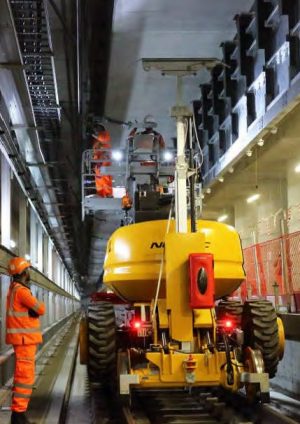This study was carried out by King’s College London on Crossrail’s behalf to characterise the exposure of mobile machinery operatives and allied personnel within the sub-surface and surface level rail construction environment. 10 operatives were recruited to the study between February and September 2017. These operatives were selected as they represented a wide range of occupations spending significant proportions of their working day underground in proximity to diesel vehicles or machinery. Following recruitment each participant was provided with a portable diesel pollution monitor (Aethlabs AE51 Microaethalometer) and GPS data logger (I-GOTU GT-600) and given appropriate training on their use. They were instructed to carry the monitor with them for 48 hours, including while at work, home and travelling. The monitors continuously logged location and pollution concentrations. Resulting time series data were tagged according to activity categories and analysed for patterns in exposure linked to
working procedures.
Three groups of workers were monitored; (i) Mobile Elevated Working Platform (MEWP) supervisor and operators, (ii) driver and shunters on a Class 66 Locomotive, and (iii) the crew of a ‘Madvac’ suction excavator. The primary purpose of the third deployment was to assess the performance of the tunnel ventilation system, which was disabled for maintenance during the first day of monitoring. Crews in each group followed a similar working pattern of briefing and preparation above ground, followed by the majority of the shift below ground.
The analysis found that, on average, most workers were exposed to higher levels of black carbon when commuting to and from site, than while on shift. This was particularly evident where workers used underground sections of the London Underground or private vehicles. The lowest levels of exposure where while indoors (at home or site office) and while commuting on above ground rail. While the tunnel ventilation system was operational, workers were exposed to lower levels of diesel exhaust while below ground than while working above ground at the railhead adjacent to the tunnel entrances. When tunnel ventilation was switched off, exposure levels increase by a factor of 3 to 5, demonstrating the efficacy of the system.
Short spikes in diesel exhaust exposure occurred amongst all workers,due to standing or working near vehicle or generator exhaust.This occurrence was more frequent in operators than foremen/supervisors and the impact was greater above ground than below, due to the active ventilation causing more rapid dispersion than natural wind. The locomotive driver had the lowest mean exposure levels due to the protective effect of his cab and position away from vehicle and machinery exhausts.
This study did not identify any breaches of occupational exposure limits and worker personal exposure levels were shown to be at least comparative to or lower than those experienced by above ground professional drivers. However, the absence of any clear ‘safe threshold’ for black carbon exposure means that employer should be encouraged to minimise exposure levels of their workers to diesel exhaust. A series of recommendations are made based on study results to ensure continuing best practice in future projects incorporating construction activities in a tunnel environment.


